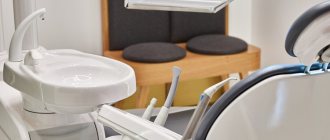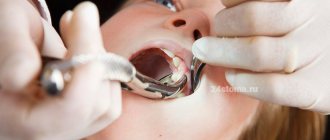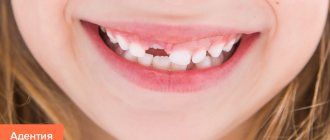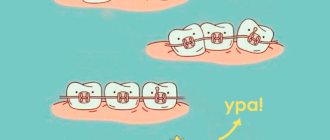- home
- Services
- Dental restoration for children
Baby teeth appear in a child from 6-9 months and are replaced by permanent teeth until the age of 12-14 years. Children's teeth, especially at an early age, are very vulnerable and susceptible to decay. It is careful attention to baby teeth that is the key to timely and correct growth of permanent dentition. A child with straight and beautiful teeth develops chewing and facial muscles correctly. Premature loss of even one baby tooth, untreated caries, crown injuries lead to the following problems:
- increased load on neighboring teeth;
- violation of growth order;
- deformations of the entire dentition;
- the occurrence of diction defects;
- deterioration of chewing function;
- aesthetic defects.
Changing the position of the rudiments of permanent teeth is a high risk of serious malocclusion, which is fraught with serious orthodontic treatment in the future. Natadent clinic specialists fight for every child’s tooth.
What is dental restoration
Restoration of baby teeth in children is carried out in the following cases:
- for damage caused by trauma;
- due to complicated caries.
Dental injuries in childhood are common. At the children's dental clinic "Natadent" we are ready to provide timely and qualified assistance. According to statistics, every third child suffers a tooth injury during sports games or vigorous activity.
By acting correctly, you can even save a knocked out tooth:
- Regardless of the severity of the injury, you should come for an examination to a pediatric dentist;
- take a photo to assess the nature of the damage;
- if displaced, the tooth must be strengthened by applying a splint or in another way at the discretion of the doctor;
- Deliver the child, along with the knocked out tooth, to the dentist’s office within 30 minutes.
Important! A knocked-out tooth cannot be picked up by the root, washed with water or treated with antiseptic solutions - this can make the process of its healing impossible and complicate restoration. It must be carefully taken by the crown and placed in saline solution, on the child’s cheek or in another biological environment.
If a piece of enamel breaks off from an injured tooth and dentin is exposed, then it cannot be left in this form. It is necessary to see a dentist and restore the damaged edge. Through a thin layer of dentin, pathogenic bacteria will enter the pulp and cause pulpitis. This can lead to tooth decay and costly treatment.
The Natadent clinic has all the possibilities for preserving teeth, restoring them and restoring them. We are sure that tooth injury is not a reason for losing it.
Teeth extension methods
There are 2 main extension methods:
- Straight. Used if tooth decay is up to 30%. During the procedure, composite or photopolymer materials are used to build teeth. The former are less durable and harden after 30 minutes. The latter have a service life of 10 years and remain plastic until exposed to the lamp.
- Indirect. Applicable when damage affects no more than 70% of the structure. The method has several stages, including taking impressions, making and installing ceramic inlays.
If you have ever thought about whether a crown or extension is better, then you should know that a crown is installed when more than 70% of the tissue is destroyed, but a intact and healthy root remains.
Recovery methods
Several methods can be used to restore a child's teeth. The type of restoration is chosen by the dentist depending on the nature and degree of destruction.
The difficulty of a dentist’s work during the process of tooth restoration is that children quickly get tired due to the need to remain static in a chair. Therefore, the Natadent Children's Dental Clinic provides the possibility of dental treatment under local anesthesia, general anesthesia or inhalation sedation.
Sealing
If a tooth is partially damaged, the dentist evaluates the condition of the remaining hard tissues and the quality of the soft tissues around the crown and roots. The following filling options are possible:
- treatment of the canals of a baby tooth and placing a filling at the gum level so that the tooth is not in the bite and does not experience stress;
- restoration using filling material.
Light-curing composite materials have many advantages:
- the dentist can completely build up a child’s tooth and recreate the crown relief;
- the chewing surface becomes durable;
- there is no release of harmful substances into the child’s body;
- the material hardens under UV light;
- You can achieve a high cosmetic effect and the required degree of transparency of the filling.
To prevent the formation of cracks during the life of the child and during shrinkage, the dentist forms a filling when building up layer by layer. The composite has the ability to hermetically close any microcracks and firmly connect to dentin.
Light-composite materials are a real innovation in dentistry, with the help of which filling and restoration of teeth has become less traumatic and most effective.
Crown installation
Carrying out this procedure in children is surprising, but not among the specialists at the Natadent clinic.
It is recommended to use the following method:
- for large chips;
- with significant tooth destruction of 50% or more.
If the chewing surface and one of the side walls of the tooth are lost, the remaining thin walls will not withstand the chewing load for a long time.
Installing a crown is a reliable way to save a baby tooth from destruction and maintain its functionality until it is replaced with a permanent one.
Crowns help:
- chew food thoroughly, which is important for the vulnerable gastrointestinal tract system;
- prevent the appearance of persistent speech defects, which is especially important during the period of active development of the child and preparation for school;
- form the correct bite.
Timely protection of teeth with crowns is an opportunity to minimize further destruction of baby teeth, the development of secondary caries and prevent improper development of permanent teeth.
Natadent pediatric dentistry uses two types of crowns:
- ceramic for the front teeth, which do not differ from natural incisors in color and shape and do not violate the aesthetics of the smile;
- metal, made of stainless steel, which are the ideal solution for restoring the function of chewing teeth.
Modern crowns are high-quality products with a unique design; they do not require significant grinding of the tooth, but significantly prolong its life. At the clinics of the Natadent network, we restore teeth for children in the same aesthetic and beautiful way as for adults.
Indications and contraindications for tooth augmentation
Teeth augmentation is a multi-stage technology for restoring the aesthetic appearance and functions of the jaw, which was susceptible to chipping or erased as a result of increased tone of the masticatory muscles, called buxism.
Indications for the tooth augmentation procedure:
- chips resulting from injuries;
- numerous caries lesions;
- large distance between teeth;
- wedge-shaped defect;
- the presence of a gap between the two front teeth;
- congenital structural pathologies;
- thinning and demineralization of enamel due to consumption of junk food and lack of oral hygiene;
- cervical caries;
- the presence of errors in previous dental sessions that resulted in the destruction of healthy tissue;
- malocclusion.
Having asked the dentist a question about what tooth extension is called, the patient will immediately hear the answer. The procedure is called dentition restoration. Modern extension technologies make it possible to restore the structure in most cases without resorting to its removal. The procedure is harmless, but has a number of contraindications:
- patient age – more than 60 years;
- children's age when using pins;
- presence of a cyst;
- inflammation of the gums;
- pregnancy in the first or third trimester;
- failure to comply with personal hygiene rules;
- periodontitis and stomatitis;
- jaw fracture and other injuries.
If a patient is diagnosed with diseases that are contraindications, the dentist first treats them, and then restores the dentition.
Reviews
Your feedback is to help potential patients make the right choice. Leave your suggestions or comments so we can work even better.
LEAVE FEEDBACK
Tooth extension onto a pin
When thinking about whether it is possible to build a tooth onto the root, the use of a pin comes to mind. It is used if both the body and the root are severely damaged.
The procedure includes:
- obtaining an x-ray;
- cleaning the mouth, removing stones;
- removal of damaged areas;
- computer tooth modeling;
- removal of saliva;
- anesthesia;
- cleaning of channels;
- implantation of a pin, cleansing the area around it;
- filling the space around the pin with a composite or photopolymer;
- polishing and grinding.
Dentists build up teeth under crowns only if the remainder is in good condition and does not rot or decompose.
How to choose a clinic for prosthetics of baby teeth?
When choosing a clinic for prosthetics of baby teeth, it is necessary to study information about the institutions performing this procedure, and, in particular, find out whether they have licenses to provide dental services to children. There are few such clinics, but you should still be puzzled by finding exactly the dentistry where your child will be provided with professional assistance in prosthetics of baby teeth by specialists with appropriate qualifications.
How to care for children's dentures?
Children should care for dentures in the same way as natural teeth. You should brush your teeth twice a day and after every meal. If there are no necessary conditions for this, rinsing with clean water and using dental floss is acceptable. In some cases, depending on the material of the dentures, it is necessary to carry out regular professional cleaning of the dentures in the dental office.
Types of dentures for children
Typically, children are fitted with fixed, removable or conditionally removable dentures. Removable (temporary) dentures are made according to individual jaw impressions, sometimes with additional elements (screws, springs, arches). In children's dental prosthetics, they are installed when several teeth are missing to widen the jaw or correct the position of the teeth, and they must be regularly replaced as the child grows. Fixed dentures are installed for long-term wear and are removed along with the falling out milk teeth.
Development of tactics for correcting a child’s bite
Since the child is at an age when baby teeth are actively falling out and permanent teeth are erupting in their place (changeable bite), it is necessary first of all to create a place for the normal eruption of permanent teeth. Based on the current situation, it is necessary to increase the size of the upper jaw. Then you need to move the displaced teeth into place, allow all permanent teeth to erupt and align their position if necessary.
Commentary by speech therapist, myofunctional therapist T.B. Zukor: “When carrying out orthodontic treatment, it is not enough to just correct the position of the teeth; it is necessary to eliminate the cause of the malocclusion. In this case, mouth breathing was observed, as there were ENT problems. I, as a myofunctional therapist, can retrain a child from habitual mouth breathing to nose breathing, but only on condition that the nose is breathing! That is, the participation of an ENT specialist is required, who, for his part, will eliminate the existing problems. The stability of the result of bite correction directly depends on eliminating the causes of the disorder! If you don’t normalize breathing through your nose and restore the correct balance of the muscles of the tongue, cheeks and lips, you will have to wear retainers for a very long time, and maybe for life, since the teeth will constantly strive to get back into position incorrectly.”
Treatment plan:
Stage 1 - Expansion of the upper jaw.
A McNamara appliance will be used to expand the upper jaw. This is a fixed orthodontic plate appliance with a screw. The device is made individually based on impressions and is attached with rings or trays to the distant teeth. Using a screw, the device moves apart, stimulating the expansion of the upper jaw.
Stage 2 – Distalization (movement) of chewing teeth.
The chewing teeth that have been displaced due to the early removal of baby teeth must be moved to their place and pushed back. To move the teeth a sufficient distance, the Pendulum device will be used, which applies pressure to individual teeth, causing them to move in a given direction. The device is made individually using dental impressions and is fixed on the teeth for permanent wear.
Stage 3 – Eruption of permanent teeth.
At this stage, the child will not wear any orthodontic appliances, but will only be under the supervision of an orthodontist.
Stage 4 – Teeth straightening with braces.
Braces will be installed on permanent teeth, which will help set the teeth in the correct positions and create physiological interdental contacts.
Throughout all 4 stages of treatment.
It is recommended to undergo treatment by an ENT specialist (to eliminate the causes that interfere with breathing through the nose) and correction of the balance of the facial muscles by a speech therapist - myofunctional therapist to obtain a stable result of bite correction.
Commentary by orthodontist M.P. Sleptsova: “The child is still small, his teeth are only baby teeth, and the narrowing of the upper jaw is significant. Braces cannot correct this; they do not expand the jaw. In addition, sufficient distalization (movement back) of the distant teeth was necessary to prepare the site for the eruption of permanent teeth. Braces cannot cope with this task either. If the parents had not contacted the orthodontist in time, then it would have been possible to straighten the teeth only by removing some teeth or by surgically widening the jaw. It is also important to involve an ENT specialist and a speech therapist in the treatment in order to eliminate the incorrect type of breathing and get a stable result.”
Features of dental prosthetics in children
Children's dental prosthetics has its own nuances. Firstly, in adults the jaw is formed, while the child is growing all the time, and the dentist must do everything possible to ensure that the prosthetics of baby teeth does not disrupt the development processes in the body. Therefore, dentures for children must be hypoallergenic, safe, comfortable, and resistant to chemicals. Therefore, for the manufacture of children's dentures, materials such as acrylic, chrome-plated steel, stainless steel, silver and tin alloys are used. Secondly, children's structures should not interfere with jaw development.
According to their purpose, dentures for children are divided into the following groups:
- therapeutic – restore functions and correct the structure of teeth;
- preventive – prevent deformations and pathologies in the development of teeth and jaws;
- fixing – used for fastening orthodontic appliances and therapeutic materials.
Interesting fact!
Hippocrates called children's teeth milk teeth. He was convinced that the first set of human teeth developed from the milk that infants fed.
Result of bite correction
The total duration of treatment was 4 years, of which the child did not wear orthodontic equipment for about a year while waiting for teeth to erupt.
The photo shows teeth before and after orthodontic treatment:
As a result of widening the upper jaw and straightening the teeth, we received a correct bite, physiological interdental contacts, improved facial proportions and a beautiful smile, which added self-confidence to the young man.
Let's understand the extent of damage to dental tissues
The proposed method of aesthetic restoration of a dental crown will depend on the degree of its damage.
- The appearance of a crack or chip in the enamel is considered minimal.
- They speak of average when not only the enamel breaks off, but also the dentin located underneath it.
- If the pulp chamber is opened and the nerve is exposed, we are talking about severe damage. It is clear that in this case, before dental prosthetics in Moscow, the pulp will have to be removed and the canals treated.
the tooth wall to break off during an injury , there must also be a certain internal reason. Such troubles occur much more often in people with low acidity in the mouth, with an incorrect bite, with teeth crowded and rotated around their axis, and with hormonal imbalance. Bad habits can also be the cause: from smoking and alcohol abuse to excessive indulgence in sweets and carbohydrate foods.
What complications can there be?
If the chip is minor and does not cause discomfort, this does not mean that you can ignore it. Damage will lead to further destruction of hard tissues, and then dentin and pulp will be at risk. If the neurovascular bundle is damaged, the child will inevitably experience severe piercing pain, and further treatment may require removal of the nerve.
In addition, the presence of injured elements in the oral cavity creates favorable conditions for the proliferation of bacteria and infection of tissues. In addition to serious dental problems, this can lead to the development of diseases of the liver and kidneys, digestive and cardiovascular systems.











